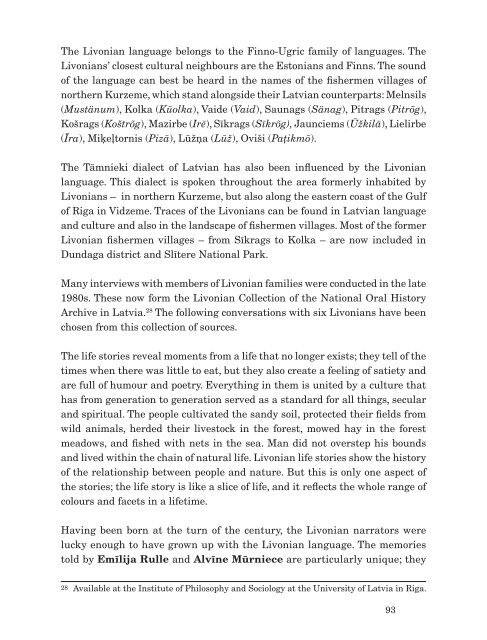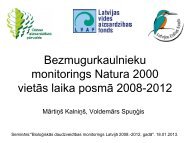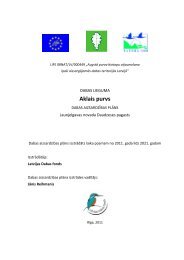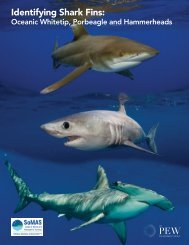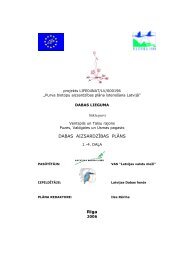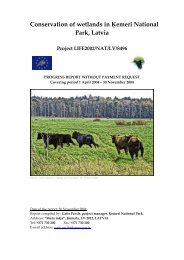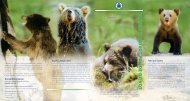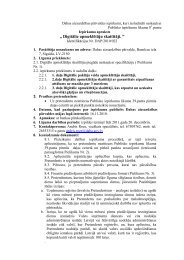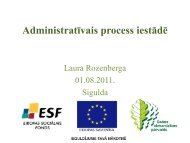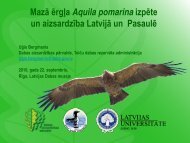Lībieši Ziemeļkurzemes ainavā - Dabas aizsardzības pārvalde
Lībieši Ziemeļkurzemes ainavā - Dabas aizsardzības pārvalde
Lībieši Ziemeļkurzemes ainavā - Dabas aizsardzības pārvalde
You also want an ePaper? Increase the reach of your titles
YUMPU automatically turns print PDFs into web optimized ePapers that Google loves.
The Livonian language belongs to the Finno-Ugric family of languages. The<br />
Livonians’ closest cultural neighbours are the Estonians and Finns. The sound<br />
of the language can best be heard in the names of the fishermen villages of<br />
northern Kurzeme, which stand alongside their Latvian counterparts: Melnsils<br />
(Mustänum), Kolka (Kūolka), Vaide (Vaid), Saunags (Sänag), Pitrags (Pitrõg),<br />
Košrags (Koštrõg), Mazirbe (Irē), Sīkrags (Sīkrõg), Jaunciems (Ūžkilā), Lielirbe<br />
(Īra), Miķeļtornis (Pizā), Lūžņa (Lūž), Oviši (Paţikmō).<br />
The Tāmnieki dialect of Latvian has also been influenced by the Livonian<br />
language. This dialect is spoken throughout the area formerly inhabited by<br />
Livonians – in northern Kurzeme, but also along the eastern coast of the Gulf<br />
of Riga in Vidzeme. Traces of the Livonians can be found in Latvian language<br />
and culture and also in the landscape of fishermen villages. Most of the former<br />
Livonian fishermen villages – from Sīkrags to Kolka – are now included in<br />
Dundaga district and Slītere National Park.<br />
Many interviews with members of Livonian families were conducted in the late<br />
1980s. These now form the Livonian Collection of the National Oral History<br />
Archive in Latvia. 28 The following conversations with six Livonians have been<br />
chosen from this collection of sources.<br />
The life stories reveal moments from a life that no longer exists; they tell of the<br />
times when there was little to eat, but they also create a feeling of satiety and<br />
are full of humour and poetry. Everything in them is united by a culture that<br />
has from generation to generation served as a standard for all things, secular<br />
and spiritual. The people cultivated the sandy soil, protected their fields from<br />
wild animals, herded their livestock in the forest, mowed hay in the forest<br />
meadows, and fished with nets in the sea. Man did not overstep his bounds<br />
and lived within the chain of natural life. Livonian life stories show the history<br />
of the relationship between people and nature. But this is only one aspect of<br />
the stories; the life story is like a slice of life, and it reflects the whole range of<br />
colours and facets in a lifetime.<br />
Having been born at the turn of the century, the Livonian narrators were<br />
lucky enough to have grown up with the Livonian language. The memories<br />
told by Emīlija Rulle and Alvīne Mūrniece are particularly unique; they<br />
28 Available at the Institute of Philosophy and Sociology at the University of Latvia in Riga.<br />
93


